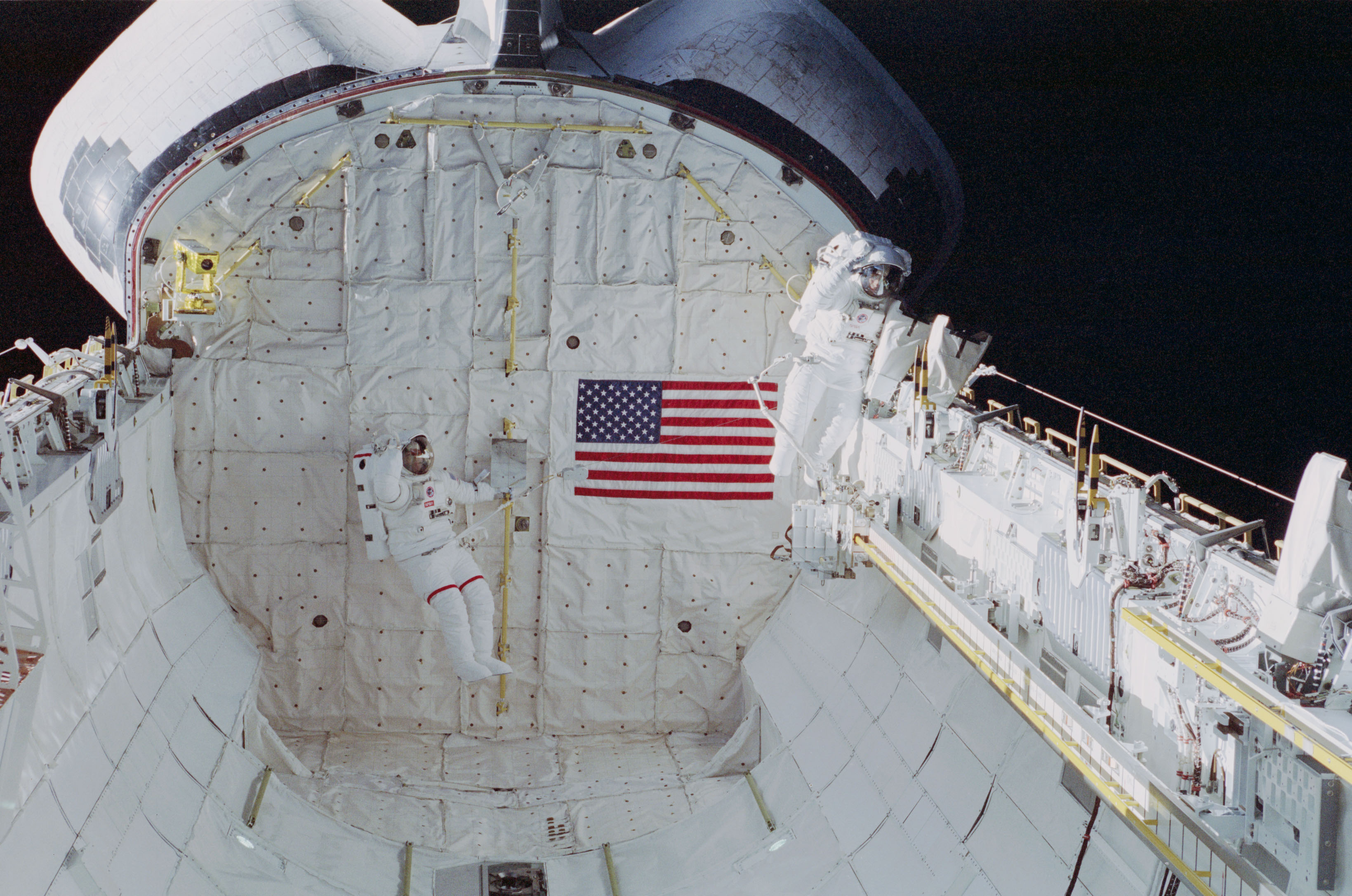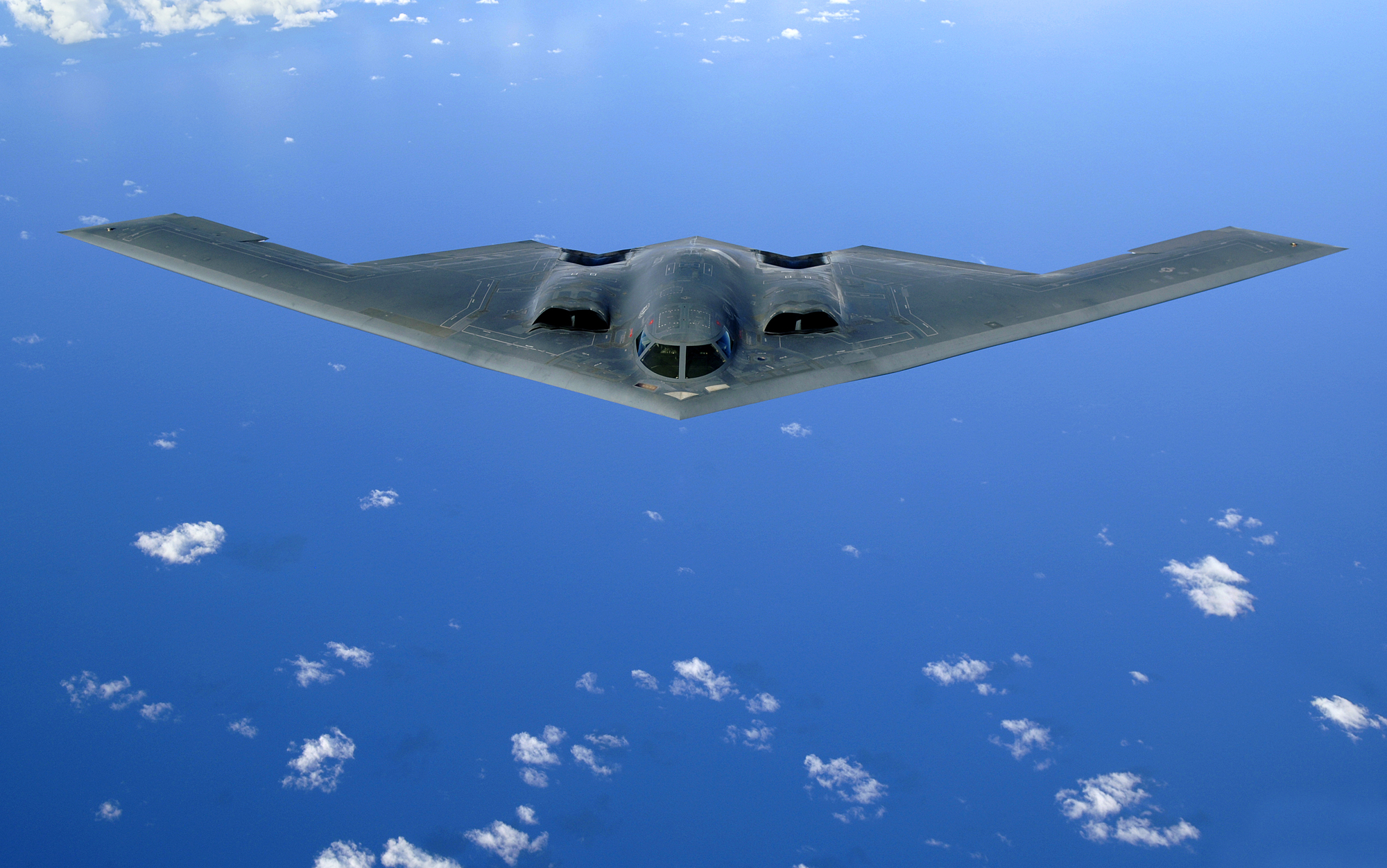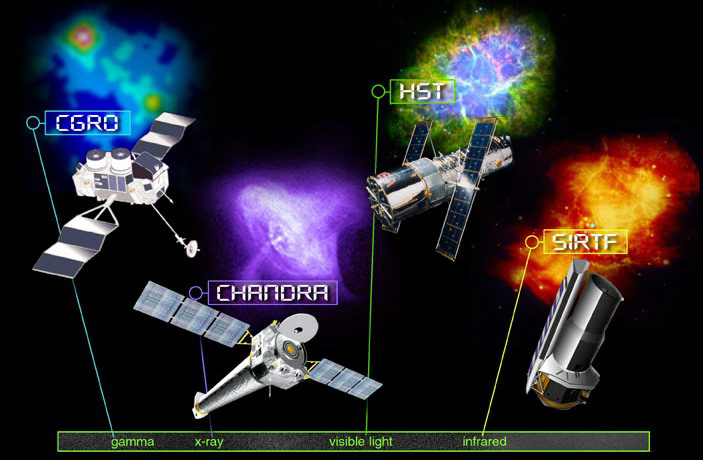|
OSSE
The Compton Gamma Ray Observatory (CGRO) was a space observatory detecting photons with energies from 20 k eV to 30 GeV, in Earth orbit from 1991 to 2000. The observatory featured four main telescopes in one spacecraft, covering X-rays and gamma rays, including various specialized sub-instruments and detectors. Following 14 years of effort, the observatory was launched from Space Shuttle ''Atlantis'' during STS-37 on April 5, 1991, and operated until its deorbit on June 4, 2000. It was deployed in low Earth orbit at to avoid the Van Allen radiation belt. It was the heaviest astrophysical payload ever flown at that time at . Costing $617 million, the CGRO was part of NASA's "Great Observatories" series, along with the Hubble Space Telescope, the Chandra X-ray Observatory, and the Spitzer Space Telescope. It was the second of the series to be launched into space, following the Hubble Space Telescope. The CGRO was named after Arthur Compton, an American physicist ... [...More Info...] [...Related Items...] OR: [Wikipedia] [Google] [Baidu] |
CGRO S37-96-010
The Compton Gamma Ray Observatory (CGRO) was a space observatory detecting photons with energies from 20 k eV to 30 GeV, in Earth orbit from 1991 to 2000. The observatory featured four main telescopes in one spacecraft, covering X-rays and gamma rays, including various specialized sub-instruments and detectors. Following 14 years of effort, the observatory was launched from Space Shuttle ''Atlantis'' during STS-37 on April 5, 1991, and operated until its deorbit on June 4, 2000. It was deployed in low Earth orbit at to avoid the Van Allen radiation belt. It was the heaviest astrophysical payload ever flown at that time at . Costing $617 million, the CGRO was part of NASA's " Great Observatories" series, along with the Hubble Space Telescope, the Chandra X-ray Observatory, and the Spitzer Space Telescope. It was the second of the series to be launched into space, following the Hubble Space Telescope. The CGRO was named after Arthur Compton, an American physicis ... [...More Info...] [...Related Items...] OR: [Wikipedia] [Google] [Baidu] |
STS-37
STS-37, the thirty-ninth NASA Space Shuttle mission and the eighth flight of the Space Shuttle Atlantis, Space Shuttle ''Atlantis'', was a six-day mission with the primary objective of launching the Compton Gamma Ray Observatory (CGRO), the second of the Great Observatories program which included the visible-spectrum Hubble Space Telescope (HST), the Chandra X-ray Observatory (CXO) and the infrared Spitzer Space Telescope. The mission also featured two Extravehicular activity, spacewalks, the first since 1985. Crew Spacewalks * '' Ross and Apt '' – EVA 1 * EVA 1 Start: April 7, 1991 * EVA 1 End: April 7, 1991 * Duration: 4 hours, 32 minutes * '' Ross and Apt '' – EVA 2 * EVA 2 Start: April 8, 1991 * EVA 2 End: April 8, 1991 * Duration: 5 hours, 57 minutes Crew seating arrangements Preparations and launch The STS-37 mission was successfully launched from launch pad 39B at 9:22:44 a.m. Eastern Time Zone, EST on April 5, 1991, from the Kennedy Space Center in F ... [...More Info...] [...Related Items...] OR: [Wikipedia] [Google] [Baidu] |
STS-37 Launch
STS-37, the thirty-ninth NASA Space Shuttle mission and the eighth flight of the Space Shuttle ''Atlantis'', was a six-day mission with the primary objective of launching the Compton Gamma Ray Observatory (CGRO), the second of the Great Observatories program which included the visible-spectrum Hubble Space Telescope (HST), the Chandra X-ray Observatory (CXO) and the infrared Spitzer Space Telescope. The mission also featured two spacewalks, the first since 1985. Crew Spacewalks * '' Ross and Apt '' – EVA 1 * EVA 1 Start: April 7, 1991 * EVA 1 End: April 7, 1991 * Duration: 4 hours, 32 minutes * '' Ross and Apt '' – EVA 2 * EVA 2 Start: April 8, 1991 * EVA 2 End: April 8, 1991 * Duration: 5 hours, 57 minutes Crew seating arrangements Preparations and launch The STS-37 mission was successfully launched from launch pad 39B at 9:22:44 a.m. EST on April 5, 1991, from the Kennedy Space Center in Florida. Resumption of the countdown after the T-9-minute hold was ... [...More Info...] [...Related Items...] OR: [Wikipedia] [Google] [Baidu] |
Photon Energy
Photon energy is the energy carried by a single photon. The amount of energy is directly proportional to the photon's electromagnetic frequency and thus, equivalently, is inversely proportional to the wavelength. The higher the photon's frequency, the higher its energy. Equivalently, the longer the photon's wavelength, the lower its energy. Photon energy can be expressed using any unit of energy. Among the units commonly used to denote photon energy are the electronvolt (eV) and the joule (as well as its multiples, such as the microjoule). As one joule equals 6.24 × 1018 eV, the larger units may be more useful in denoting the energy of photons with higher frequency and higher energy, such as gamma rays, as opposed to lower energy photons as in the optical and radio frequency regions of the electromagnetic spectrum. Formulas Physics Photon energy is directly proportional to frequency. E = hf where *E is energy *h is the Planck constant * f is frequency This equation is known ... [...More Info...] [...Related Items...] OR: [Wikipedia] [Google] [Baidu] |
Northrop Grumman
Northrop Grumman Corporation is an American multinational aerospace and defense technology company. With 90,000 employees and an annual revenue in excess of $30 billion, it is one of the world's largest weapons manufacturers and military technology providers. The firm ranks on the 2022 ''Fortune'' 500 list of America's largest corporations. Northrop Grumman and its industry partners have won the Collier Trophy eight times, most recently for developing the X-47B, the first unmanned, autonomous air system to operate from an aircraft carrier. Northrop Grumman currently leads the development of the B-21 Raider, a long-range, stealth strategic bomber that can drop conventional and nuclear weapons; it will replace Northrop's own B-2 Spirit, the world's only known stealth bomber. Among its other current projects are development and production of the James Webb Space Telescope, an orbiting observatory launched in 2021, and production of the solid rocket boosters for NASA's Space ... [...More Info...] [...Related Items...] OR: [Wikipedia] [Google] [Baidu] |
Washington University In St
Washington commonly refers to: * Washington (state), United States * Washington, D.C., the capital of the United States ** A metonym for the federal government of the United States ** Washington metropolitan area, the metropolitan area centered on Washington, D.C. * George Washington George Washington (February 22, 1732, 1799) was an American military officer, statesman, and Founding Father who served as the first president of the United States from 1789 to 1797. Appointed by the Continental Congress as commander of th ... (1732–1799), the first president of the United States Washington may also refer to: Places England * Washington, Tyne and Wear, a town in the City of Sunderland metropolitan borough ** Washington Old Hall, ancestral home of the family of George Washington * Washington, West Sussex, a village and civil parish Greenland * Cape Washington, Greenland * Washington Land Philippines *New Washington, Aklan, a municipality *Washington, a barangay in Catar ... [...More Info...] [...Related Items...] OR: [Wikipedia] [Google] [Baidu] |
Arthur Compton
Arthur Holly Compton (September 10, 1892 – March 15, 1962) was an American physicist who won the Nobel Prize in Physics in 1927 for his 1923 discovery of the Compton effect, which demonstrated the particle nature of electromagnetic radiation. It was a sensational discovery at the time: the wave nature of light had been well-demonstrated, but the idea that light had both wave and particle properties was not easily accepted. He is also known for his leadership over the Metallurgical Laboratory at the University of Chicago during the Manhattan Project, and served as chancellor of Washington University in St. Louis from 1945 to 1953. In 1919, Compton was awarded one of the first two National Research Council Fellowships that allowed students to study abroad. He chose to go to the University of Cambridge's Cavendish Laboratory in England, where he studied the scattering and absorption of gamma rays. Further research along these lines led to the discovery of the Compton ef ... [...More Info...] [...Related Items...] OR: [Wikipedia] [Google] [Baidu] |
Spitzer Space Telescope
The Spitzer Space Telescope, formerly the Space Infrared Telescope Facility (SIRTF), was an infrared space telescope launched in 2003. Operations ended on 30 January 2020. Spitzer was the third space telescope dedicated to infrared astronomy, following IRAS (1983) and ISO (1995–1998). It was the first spacecraft to use an Earth-trailing orbit, later used by the Kepler planet-finder. The planned mission period was to be 2.5 years with a pre-launch expectation that the mission could extend to five or slightly more years until the onboard liquid helium supply was exhausted. This occurred on 15 May 2009. Without liquid helium to cool the telescope to the very low temperatures needed to operate, most of the instruments were no longer usable. However, the two shortest-wavelength modules of the IRAC camera continued to operate with the same sensitivity as before the helium was exhausted, and continued to be used into early 2020 in the Spitzer Warm Mission. During the warm mission, t ... [...More Info...] [...Related Items...] OR: [Wikipedia] [Google] [Baidu] |
Chandra X-ray Observatory
The Chandra X-ray Observatory (CXO), previously known as the Advanced X-ray Astrophysics Facility (AXAF), is a Flagship-class space telescope launched aboard the during STS-93 by NASA on July 23, 1999. Chandra is sensitive to X-ray sources 100 times fainter than any previous X-ray telescope, enabled by the high angular resolution of its mirrors. Since the Earth's atmosphere absorbs the vast majority of X-rays, they are not detectable from Earth-based telescopes; therefore space-based telescopes are required to make these observations. Chandra is an Earth satellite in a 64-hour orbit, and its mission is ongoing . Chandra is one of the Great Observatories, along with the Hubble Space Telescope, Compton Gamma Ray Observatory (1991–2000), and the Spitzer Space Telescope (2003–2020). The telescope is named after the Nobel Prize-winning Indian-American astrophysicist Subrahmanyan Chandrasekhar. Its mission is similar to that of ESA's XMM-Newton spacecraft, also launched in ... [...More Info...] [...Related Items...] OR: [Wikipedia] [Google] [Baidu] |
Hubble Space Telescope
The Hubble Space Telescope (often referred to as HST or Hubble) is a space telescope that was launched into low Earth orbit in 1990 and remains in operation. It was not the first space telescope, but it is one of the largest and most versatile, renowned both as a vital research tool and as a public relations boon for astronomy. The Hubble telescope is named after astronomer Edwin Hubble and is one of NASA's Great Observatories. The Space Telescope Science Institute (STScI) selects Hubble's targets and processes the resulting data, while the Goddard Space Flight Center (GSFC) controls the spacecraft. Hubble features a mirror, and its five main instruments observe in the ultraviolet, visible, and near-infrared regions of the electromagnetic spectrum. Hubble's orbit outside the distortion of Earth's atmosphere allows it to capture extremely high-resolution images with substantially lower background light than ground-based telescopes. It has recorded some of the most detaile ... [...More Info...] [...Related Items...] OR: [Wikipedia] [Google] [Baidu] |
Great Observatories Program
NASA's series of Great Observatories satellites are four large, powerful space-based astronomical telescopes launched between 1990 and 2003. They were built with different technology to examine specific wavelength/energy regions of the electromagnetic spectrum: gamma rays, X-rays, visible and ultraviolet light, and infrared light. * The Hubble Space Telescope (HST) primarily observes visible light and near-ultraviolet. It was launched in 1990 aboard the Space Shuttle ''Discovery'' during STS-31. In 1997 the STS-82 servicing mission added capability in the near-infrared range, and in 2009 the STS-125 mission fixed the telescope and extended its projected service life. * The Compton Gamma Ray Observatory (CGRO) primarily observed gamma rays, though it extended into hard x-rays as well. It was launched in 1991 aboard ''Atlantis'' during STS-37 and was de-orbited in 2000 after a gyroscope failed. * The Chandra X-ray Observatory (CXO) primarily observes soft X-rays. It was launc ... [...More Info...] [...Related Items...] OR: [Wikipedia] [Google] [Baidu] |








